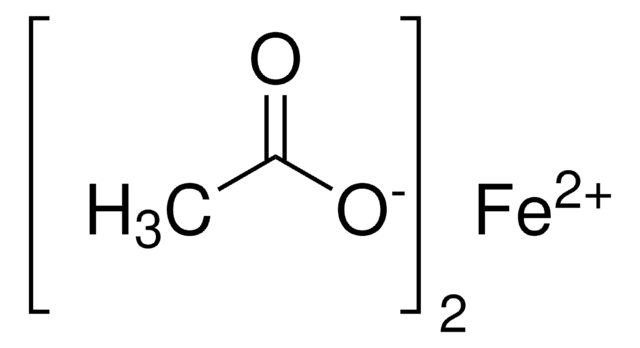413054
Iron
granular, 10-40 mesh, >99.99% trace metals basis
Synonym(s):
Ferrum, Iron metal
About This Item
Recommended Products
Assay
>99.99% trace metals basis
form
granular
resistivity
9.71 μΩ-cm
particle size
10-40 mesh
bp
2750 °C (lit.)
mp
1535 °C (lit.)
density
7.86 g/mL at 25 °C (lit.)
SMILES string
[Fe]
InChI
1S/Fe
InChI key
XEEYBQQBJWHFJM-UHFFFAOYSA-N
General description
Application
- Progress and perspectives on iron-based electrode materials for alkali metal-ion batteries: a critical review.: This review explores the recent advancements and future prospects of iron-based electrode materials in alkali metal-ion batteries, highlighting their potential for high energy density and sustainable energy storage solutions (Li et al., 2024).
- Iron-Based Electrodes Meet Water-Based Preparation, Fluorine-Free Electrolyte and Binder: : This study examines the use of water-based preparation methods and fluorine-free electrolytes in the development of iron-based electrodes, proposing a more sustainable approach to lithium-ion battery production (Valvo et al., 2017).
Signal Word
Warning
Hazard Statements
Precautionary Statements
Hazard Classifications
Flam. Sol. 2 - Self-heat. 2
Storage Class Code
4.2 - Pyrophoric and self-heating hazardous materials
WGK
nwg
Flash Point(F)
69.8 °F
Flash Point(C)
21 °C
Certificates of Analysis (COA)
Search for Certificates of Analysis (COA) by entering the products Lot/Batch Number. Lot and Batch Numbers can be found on a product’s label following the words ‘Lot’ or ‘Batch’.
Already Own This Product?
Find documentation for the products that you have recently purchased in the Document Library.
Customers Also Viewed
Articles
The price of tellurium, a key component in many thermoelectric materials, has risen in recent years, leading to the search for more cost-effective substitutes. This article presents silicide materials as a cheaper potential alternative.
The unique properties of the rare-earth elements and their alloys have brought them from relative obscurity to high profile use in common hightech applications.
Our team of scientists has experience in all areas of research including Life Science, Material Science, Chemical Synthesis, Chromatography, Analytical and many others.
Contact Technical Service



